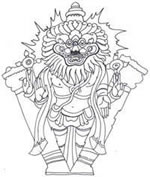The Ten Avataras 4
A Psychological Study of the Evolution of Humankind
Swami Satyadharma Saraswati
4. NARASIMHA AVATARA
 The
first three avataras: Matsya, the fish, Kurma, the tortoise, and Varaha,
the boar, relate to ancient creation myths, but the fourth is more recent.
From the viewpoint of creation, the watery, milky and solid states have
been passed. The first three emanations represent the earliest stages
of evolution when consciousness was undefined and primitive. These stages
are thus symbolised by animal incarnations which represent water and earth,
the fundamental strata from which all higher life forms will develop.
In the fourth incarnation, the Lord takes an anthropomorphic form, which
indicates the transition point where man is evolving from the animal to
human form, and consciousness begins its development from pure instinct
to self-awareness.
The
first three avataras: Matsya, the fish, Kurma, the tortoise, and Varaha,
the boar, relate to ancient creation myths, but the fourth is more recent.
From the viewpoint of creation, the watery, milky and solid states have
been passed. The first three emanations represent the earliest stages
of evolution when consciousness was undefined and primitive. These stages
are thus symbolised by animal incarnations which represent water and earth,
the fundamental strata from which all higher life forms will develop.
In the fourth incarnation, the Lord takes an anthropomorphic form, which
indicates the transition point where man is evolving from the animal to
human form, and consciousness begins its development from pure instinct
to self-awareness.
In this myth, Vishnu descends in the form of Narasimha, who is half man (nara) and half lion (simha). The fourth avatara is linked to the third by the two brothers, Hiranyaksha and Hiranyakshipu. After conquering Hiranyaksha, Vishnu deals with Hiranyakshipu, whereby human consciousness is made manifest. Hiranyakshipu means ‘golden cloth’, hence he expands everywhere and covers everything like cloth. According to the myth, Hiranyakshipu was the arrogant ruler of Patala, the lowest realm of existence. He had also performed a fierce form of tapasya for which Brahma had given him the boon that he could be killed neither by gods nor by humans, neither by day nor by night, neither inside nor outside any dwelling, rendering him almost invincible.
Hiranyakshipu had four sons, the youngest of whom was Prahlad. The first three sons were worldly-minded and rejoiced in material power and wealth, but Prahlad was spiritually minded and rejoiced in the Divine. Even as a small boy, Prahlad was always devoted to the Lord, against his father’s injunctions. Hiranyakshipu, thus considering his youngest son to be disobedient and a threat to his supremacy, subjected him to a number of ordeals, all of which Prahlad emerged from unscathed. Finally, in despair, the father kicked his foot against a pillar on the veranda, exclaiming to his son, “You say Vishnu is everywhere, so make him come out of this pillar!” Thereupon, the Lord in the form of Narasimha issued forth from the pillar, with a human body and the head and claws of a lion, and ripped Hiranyakshipu to pieces.
In relation to human evolution, this myth signifies the descent of consciousness into the dimension of ego, or ahamkara, which covers completely, like a golden cloth, the true identity of the individual. Due to ahamkara, the consciousness identifies totally with the physical body, its associations, roles and accomplishments, and remains oblivious to the higher consciousness dwelling within. However, from this ego-bound state, represented by Hiranyakshipu, arises Prahlad, the child of buddhi, pure intellect, which is able to cognize the higher consciousness. So the father, who is blind, tries to torture the son, who sees. But at this point the higher consciousness steps in to protect buddhi and put a stop to the limiting and negative influence of ahamkara. Here the higher consciousness arises in the form of a man-lion, which was most appropriate to that age, when the human consciousness was just evolving into the ego-bound, material and sensory level of existence.
Continued in the next issue